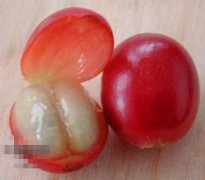Coffee bean picking-berry processing-drying process
What we call coffee beans is actually the seeds of a cherry-like fruit. Coffee trees produce berries called coffee berries, which turn bright red to indicate ripeness and are ready for picking. The fruit clustered on the branches. Coffee berries have thick, bitter outer skins (exocarp). However, the fruit inside (mesocarp) is sweet and has a grape texture. Next up is parenchyma, a sticky honey-like membrane that protects coffee beans. The beans themselves are also covered with a parchment-like coating called the endocarp. It protects two green coffee beans, and of course the beans are protected by a thin film called the seed coat or silver coat.

Coffee is usually harvested once a year. Harvest times vary depending on geographic location, but generally harvest is September to March in the Northern Hemisphere and April to May in the Southern Hemisphere. Coffee is usually picked by hand, either by pulling all the berries from the branches at once or selectively. The latter method is more expensive and only suitable for picking Arabica coffee beans.
The next step after picking is processing. There are two ways to deal with this:
Drying-The simplest and most economical way to harvest coffee berries is to put them directly in the sun and spread them out to dry. Then stir with rake and dry for seven to 10 days until moisture content is reduced to 11%. Coffee berries will turn yellow on the outside and the beans inside will rattle.
Hydrowet-The main difference between dry and hydrowet methods is that the pulp of coffee berries must be removed from the beans within 24 hours of harvest. The peel and pulp can be washed off with a pulp washer. The beans are then left to ferment for 12 to 48 hours. Natural enzymes remove the goo from the parchment coating. Then, the beans are either dried by the sun or dried by a machine.
After the beans dry, all of the coating is peeled off the beans (a process called peeling). Occasionally, machines designed to strip away what little silver remains are used. Coffee beans are then graded and classified according to size, according to specific gravity. Coffee beans are either sorted by hand on a conveyor belt or separated by a blower from the light (defective) and heavy ones
The coffee shipped is unroasted. It's called green coffee. It is usually stored in jute or pol sacks or shipped in large plastic freight containers. Up to 7 million tons of green coffee are shipped worldwide each year.
Important Notice :
前街咖啡 FrontStreet Coffee has moved to new addredd:
FrontStreet Coffee Address: 315,Donghua East Road,GuangZhou
Tel:020 38364473
- Prev

Basic knowledge of fine coffee knowledge of coffee fruit
The fruit is a berry, also known as comb fruit. Oval, 9-14 mm long, young fruit green, red at maturity, purplish red. Each fruit generally has two seeds, but also one or three, showing a semi-oval, there is a longitudinal groove, called grooves. The structure of a fruit in which the exocarp consists of a thin layer of hardwood human cells with stomata; the mesocarp (that is, pulp) is large and Lignified by several layers of polygons.
- Next

Boutique coffee common sense when can coffee beans be picked
Coffee trees usually blossom in 3-4 years, about 2-3 months a year, and their appearance and smell are similar to those of jasmine. when they bloom, they grow in clusters on the branches and bloom for 3-5 days. After the flowers bloom, they bear small green fruits, which ripen and turn red into ripe fruits that can be picked after a few months. The skin of ripe fruit is red. Because its shape and color are similar to cherries, ripe coffee fruit is called coffee cherry in many places.
Related
- Beginners will see the "Coffee pull flower" guide!
- What is the difference between ice blog purified milk and ordinary milk coffee?
- Why is the Philippines the largest producer of crops in Liberia?
- For coffee extraction, should the fine powder be retained?
- How does extracted espresso fill pressed powder? How much strength does it take to press the powder?
- How to make jasmine cold extract coffee? Is the jasmine + latte good?
- Will this little toy really make the coffee taste better? How does Lily Drip affect coffee extraction?
- Will the action of slapping the filter cup also affect coffee extraction?
- What's the difference between powder-to-water ratio and powder-to-liquid ratio?
- What is the Ethiopian local species? What does it have to do with Heirloom native species?

